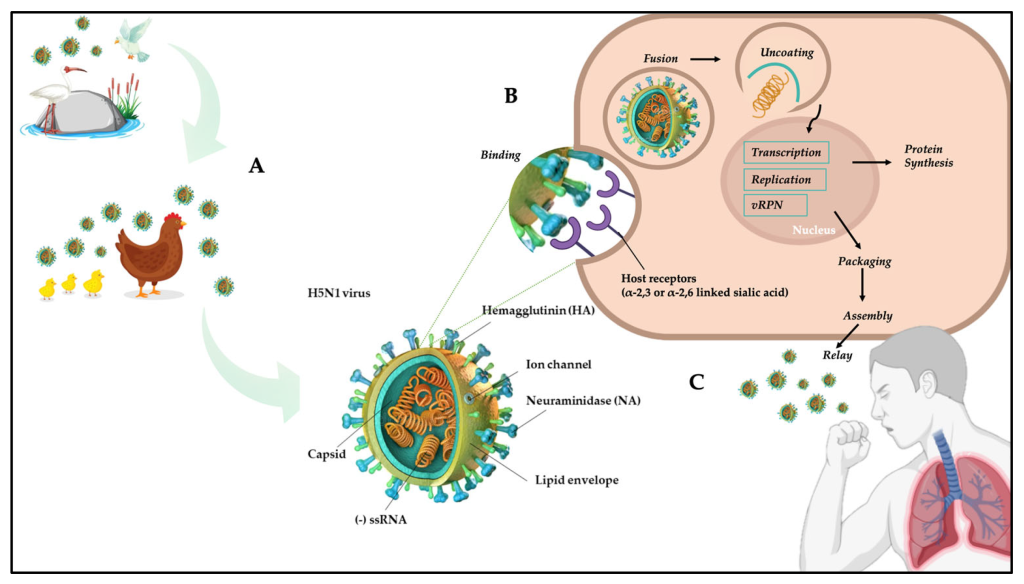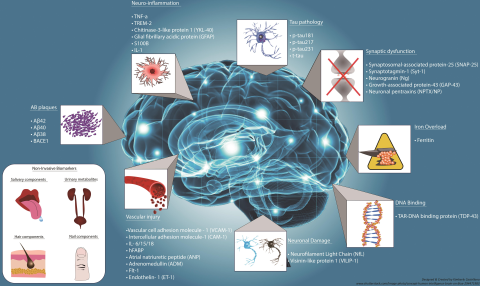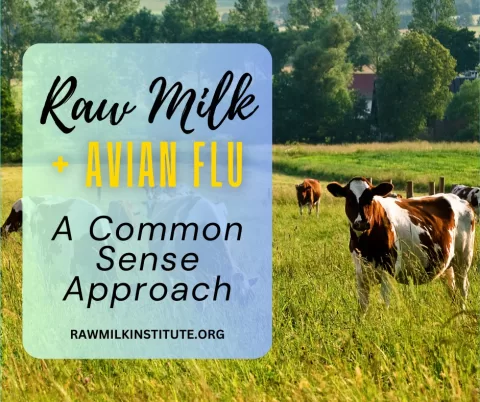The H5N1 flu virus transmission remains a critical concern for public health officials, especially with recent studies highlighting the potential for human-to-human transmission under specific mutations. Research from the Scripps Research Institute indicates that a single mutation in the H5N1 strain circulating among US dairy cows could significantly increase this risk. Although the virus has primarily caused mild illness in humans exposed to infected wildlife and livestock, its ability to mutate raises alarms about avian flu concerns. Scientists have focused on the hemagglutinin gene, crucial for the virus’s ability to attach to human cells, and how H5N1 mutations could facilitate this process. Continuous genomic surveillance is essential to monitor these changes, ensuring that we stay ahead of potential outbreaks.
The transmission of the H5N1 avian influenza virus has sparked widespread anxiety regarding its ability to spread among humans. Known for its origins in birds, this virus poses unique risks, particularly as mutations could enhance its infectious potential. Recent investigations into the pathogenicity of the virus, especially concerning strains found in livestock like dairy cows, highlight the importance of understanding human susceptibility to such zoonotic diseases. As researchers delve deeper into the genetic modifications of the virus, particularly the hemagglutinin protein, the implications of human-to-human transmission cannot be overlooked. In light of these findings, public health strategies must prioritize surveillance of H5N1 mutations to mitigate future pandemic risks.
Understanding H5N1 Flu Virus Transmission Risks
The H5N1 flu virus has been a significant concern for health authorities worldwide, especially regarding its potential to transmit from animals to humans. Recent research indicates that a single mutation in the H5N1 strain found in US dairy cows could trigger a shift towards human-to-human transmission. This alarming possibility highlights the importance of continuous monitoring and genomic surveillance to track the evolution of the virus. Scientists emphasize that while the current strains primarily cause mild illnesses in humans, the risk of mutations leading to a more transmissible form cannot be ignored.
The study from the Scripps Research Institute underscores the complexity of H5N1 mutations, particularly the changes in the hemagglutinin gene, which is crucial for the virus’s ability to attach to host cells. By understanding how these mutations affect receptor binding, researchers can better predict the conditions under which the virus might adapt to human hosts. The potential for H5N1 to mutate into a strain that can easily spread among humans remains a pressing public health concern.
The Role of Hemagglutinin Gene in Avian Flu
Hemagglutinin (HA) plays a pivotal role in the infectivity of the H5N1 flu virus, as it is responsible for binding the virus to host cells. The mutations within the hemagglutinin gene determine how effectively the virus can attach to human versus avian cell receptors. In the recent study, researchers introduced specific mutations to assess their impact on receptor specificity. The findings revealed that certain mutations could enhance the virus’s ability to bind to human cells, raising alarms about the potential for a pandemic strain.
Understanding the hemagglutinin gene’s mutations is essential for predicting how the H5N1 flu virus may evolve. While the research shows promise in identifying critical mutations, it also emphasizes that the virus must overcome several hurdles before it can efficiently spread among humans. Continuous research and surveillance of these genetic changes are vital to ensure timely responses to any emerging threats posed by H5N1.
Human-to-Human Transmission: Current Insights
The possibility of human-to-human transmission of the H5N1 virus has been a topic of intense research and debate. Although instances of human infection have largely resulted from contact with infected animals, the emergence of mutations that favor human cell binding could change this dynamic. The recent findings suggest that while the potential exists for H5N1 to adapt for human transmission, further mutations are necessary for it to become a significant threat to public health.
Experts stress that while the mutations identified in laboratory settings show increased binding to human receptors, this does not immediately translate to effective transmission among humans. The interplay between genetic mutations and environmental factors will play a crucial role in determining whether H5N1 can evolve into a transmissible strain. Ongoing research and vigilant surveillance are essential to mitigate the risks associated with this virus.
Monitoring H5N1 Mutations in Dairy Cows
H5N1 has been detected in various animal populations, including dairy cows, which raises concerns about the virus’s potential to mutate and infect humans. The study conducted by the Scripps Research Institute specifically analyzed the H5N1 strain present in US dairy cows, highlighting how mutations could facilitate a shift towards human transmissibility. This underscores the need for rigorous monitoring of livestock health and the genetic changes occurring within the virus.
Dairy cows, being in close contact with humans, serve as a critical interface for potential zoonotic transmission. Health authorities are urged to implement robust surveillance programs to track H5N1 mutations in these animals. Such measures will not only help in understanding the evolutionary trajectory of the virus but also in preventing possible spillover events that could lead to human infections.
Avian Flu Concerns Amid H5N1 Surveillance
The ongoing concerns surrounding avian flu, particularly H5N1, are heightened by reports of increasing human infections linked to contact with infected animals. The study emphasizes the importance of genomic surveillance to monitor the emergence of mutations within the H5N1 virus. This proactive approach is crucial for identifying potential risks and implementing timely public health interventions.
Public health officials are particularly worried about the possibility of H5N1 mutations resulting in more virulent strains that could easily spread among humans. Understanding the relationship between avian flu in birds and its potential to infect humans is essential for developing effective strategies to mitigate risks. Continuous research into the virus’s genetic makeup will help in preparing for any future outbreaks.
The Rapid Mutation of Influenza Viruses
Influenza viruses, including H5N1, are known for their rapid mutation capabilities, which pose significant challenges for public health. The ability of the virus to adapt quickly can lead to new strains that may evade existing immunity in populations. Recent reports have highlighted how H5N1 has been observed to mutate during prolonged infections, indicating a remarkable capacity to evolve and explore new binding pathways to host cells.
Scientists emphasize the urgent need for comprehensive surveillance of influenza viruses in both animal and human populations. By understanding the mutational patterns and their implications for transmissibility, health authorities can better prepare for potential outbreaks. The dynamic nature of influenza viruses necessitates a vigilant and proactive approach to public health management.
Challenges in Predicting Pandemic Strains
Predicting the emergence of pandemic strains from H5N1 remains a complex task for researchers. The study from the Scripps Research Institute illustrates that while certain mutations can enhance receptor binding, other factors must also align for the virus to effectively transmit among humans. Experts caution against jumping to conclusions about the imminent risk of a pandemic, highlighting the need for more data and research.
Understanding the multifaceted nature of viral mutations and their interaction with human biology is essential for accurate risk assessment. Additionally, researchers are exploring various pathways through which H5N1 could adapt, emphasizing the importance of continued surveillance and research in this field. The potential for H5N1 to evolve into a pandemic strain underscores the critical need for global cooperation in monitoring and managing influenza viruses.
Importance of Genomic Surveillance in Public Health
Genomic surveillance has become increasingly vital in understanding and controlling the spread of infectious diseases like H5N1. By closely monitoring genetic changes in the virus, health authorities can identify emerging mutations that may enhance transmissibility or virulence. This proactive approach allows for timely public health responses and can reduce the risk of widespread outbreaks.
Incorporating genomic data into public health strategies is essential for addressing the challenges posed by rapidly mutating viruses. As scientists continue to study H5N1 and its potential impact on human health, the importance of integrating advanced surveillance techniques cannot be overstated. Such measures will enable health officials to stay ahead of potential threats and safeguard public health.
Future Directions in H5N1 Research
The future of H5N1 research will likely focus on understanding the implications of mutations and their potential impact on transmissibility. As scientists continue to explore the virus’s genetic makeup, they aim to identify critical changes that could signal the emergence of a pandemic strain. Ongoing research will help clarify the relationship between animal infections and the risk of human transmission.
Additionally, collaboration among researchers, public health officials, and veterinary experts will be crucial in addressing H5N1 challenges. By fostering interdisciplinary approaches, the scientific community can enhance its ability to predict and respond to potential outbreaks. Future research will undoubtedly play a pivotal role in shaping public health policies aimed at mitigating the risks associated with H5N1 and other influenza viruses.
Frequently Asked Questions
What is the potential for H5N1 flu virus transmission from dairy cows to humans?
Recent studies indicate that under certain conditions, a mutation in the H5N1 flu virus circulating in US dairy cows could enable human-to-human transmission. However, additional mutations would likely be necessary for the virus to effectively bind to human cell receptors.
How do H5N1 mutations affect its transmission capabilities?
Mutations in the H5N1 virus, particularly in its hemagglutinin gene, can enhance its ability to bind to human-type cell receptors. Such changes are critical for the virus’s potential to transmit between humans, although more mutations may be required to facilitate effective spread.
What role does the hemagglutinin gene play in H5N1 flu virus transmission?
The hemagglutinin (HA) gene is crucial for H5N1 flu virus transmission as it enables the virus to attach to host cells. Mutations in this gene can alter receptor binding, which is a vital step toward potential human-to-human transmission.
What are the current concerns regarding avian flu and H5N1 mutations?
Concerns about avian flu stem from the increasing number of H5N1 infections in humans due to contact with infected animals. Ongoing genomic surveillance is essential to monitor H5N1 mutations that may facilitate transmission among humans.
Can H5N1 flu virus transmit between humans without significant mutations?
Currently, the H5N1 flu virus has not been shown to spread effectively between humans. While certain mutations may enhance binding to human cells, considerable genetic changes are likely necessary for sustained human-to-human transmission.
What is the significance of receptor binding in H5N1 flu virus transmissibility?
Receptor binding is a fundamental step in the transmissibility of the H5N1 flu virus. Changes in how the virus recognizes and binds to host cells can significantly impact its ability to spread among humans.
Why is ongoing surveillance important for H5N1 flu virus transmission?
Ongoing surveillance is crucial to detect potential H5N1 mutations that could enable human-to-human transmission. Monitoring these changes helps public health officials prepare for and mitigate possible outbreaks.
What findings were reported about H5N1 flu virus mutations and transmissibility?
A study highlighted that specific mutations, such as Q226L and Asn 224 Lys, could enhance the H5N1 virus’s ability to bind to human cells. However, additional mutations are likely required for the virus to effectively spread among humans.
| Key Point | Details |
|---|---|
| Mutation Risk | A single mutation in H5N1 could enable human-to-human transmission under specific conditions. |
| Current Situation | H5N1 strains have caused mild illnesses in exposed individuals but have not yet transmitted between humans. |
| Research Insights | The study involved analyzing mutations in the hemagglutinin (HA) gene to understand receptor binding. |
| Key Mutations | The Gln 226 Leu (Q226L) mutation enhances binding to human cell receptors. |
| Surveillance Importance | Ongoing genomic surveillance is crucial to monitor H5N1 mutations and their implications. |
| Mutation Speed | Influenza viruses can mutate rapidly, increasing the potential for new transmissible strains. |
Summary
H5N1 flu virus transmission poses a potential risk as research indicates that a single mutation could allow the virus to spread between humans. Although current strains have primarily resulted in mild cases from animal exposure, mutations in the virus, particularly those affecting receptor binding, are critical to understanding transmission dynamics. Continued genomic surveillance is essential to detect and investigate these mutations, ensuring preparedness against any emergent pandemic threats.
The content provided on this blog (e.g., symptom descriptions, health tips, or general advice) is for informational purposes only and is not a substitute for professional medical advice, diagnosis, or treatment. Always seek the guidance of your physician or other qualified healthcare provider with any questions you may have regarding a medical condition. Never disregard professional medical advice or delay seeking it because of something you have read on this website. If you believe you may have a medical emergency, call your doctor or emergency services immediately. Reliance on any information provided by this blog is solely at your own risk.







